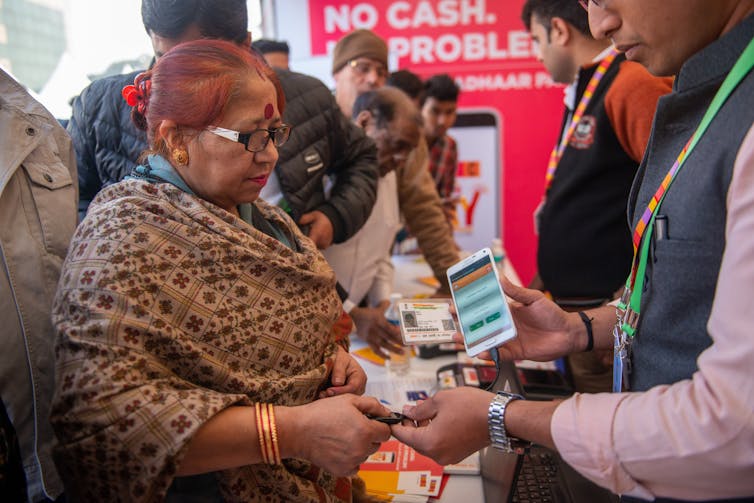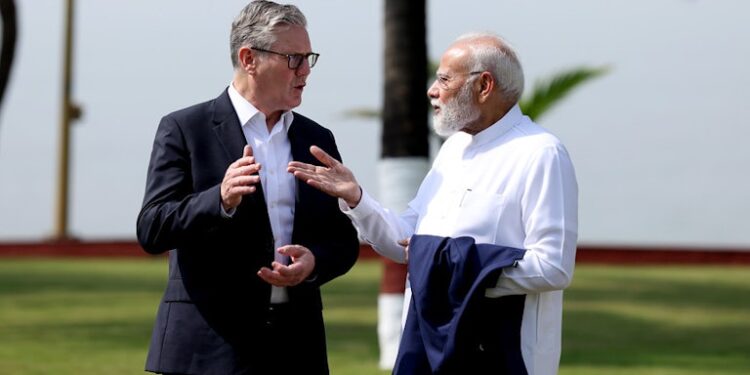Charlotte Goodburn, King’s College London
The UK government is promoting its plan for a new digital identity scheme as a way to streamline services, prevent fraud and ensure that welfare benefits reach only those entitled to them. The prime minister, Keir Starmer, has argued that digital ID is central to modernising the welfare state and tightening immigration controls.
On his recent trip to India, Starmer praised the country’s Aadhaar programme, the world’s largest digital ID system, as a “massive success”. The UK government has cited Aadhaar’s role in “reducing fraud and leakages in welfare schemes”.
But my ongoing research on India’s digital identity registration suggests that large-scale efficiency can come at significant social cost.
Aadhaar was launched in 2009, giving every Indian resident a unique 12-digit number, linked to demographic and biometric information. Its stated aim was to eliminate duplication in welfare distribution and make the system more efficient.
Fifteen years on, however, the results tell a different story. Millions of people have lost access to subsidised food, pensions and wages for public projects, sometimes for months or years at a time.
This was not because they were ineligible for the benefits, but because they failed to satisfy the system’s rigid digital conditions. These problems are ongoing.
Officials claim that Aadhaar has saved billions of rupees in welfare spending, by removing people who didn’t qualify. But research by economist Reetika Khera and colleagues shows that much of the reduction in beneficiary numbers came from the removal of legitimate claimants whose records could not be verified.
For many households, the shift to Aadhaar-linked benefits meant replacing decisions by local officials with automation. To collect subsidised food, recipients must have their number regularly authenticated online.
When internet connections fail, names are misspelt or data not updated, access can be cancelled. The same applies to pension payments and employment schemes, where officials are no longer able to override computer-generated rejections.
The effects have been severe. In Jharkhand state, an 11-year-old girl reportedly died from starvation after her family’s access to food rations was cancelled for not being linked to Aadhaar. Other deaths have been reported after households were struck from welfare lists because of data errors or missed deadlines. The victims were not impostors, but the system’s intended beneficiaries.
Digital exclusion through Aadhaar has specific impacts on women. Where their identities are linked to the mobile numbers or bank accounts of male relatives, they cannot independently authenticate their benefits, and lose access when relationships change.
Though such effects may be less pronounced in the UK, the same principle applies: digital identity systems tend to replicate existing social hierarchies.
The problem with Aadhaar is not technology alone, but how it interacts with existing institutions. Local bureaucrats are essential to making social assistance work. However, automation has curtailed their roles. Digital systems may reject applications or delay payments, while claimants are left without clear channels for appeal.
In the northwestern state of Rajasthan, thousands of pensioners went unpaid for months because errors in their Aadhaar registration were fixable only by authorities in the state capital.
Where automation replaces local, human assistance, those least able to navigate the systems – the poor, the elderly, the less literate – are most likely to lose out.
Data mobility and migration
One of Aadhaar’s stated aims was to make identity portable, allowing Indian citizens to claim benefits nationwide. In practice, this mobility has proved hard to achieve. People commonly lose access when moving between states, because data is not synchronised across administrative systems.
Making digital data mobile across bureaucracies is technically complex and socially consequential. Internal migrants and refugees can fall through the gaps. For example, people who had recently moved were unable to access COVID-19 treatment and vaccination for lack of locally-accepted Aadhaar.
Proposals indicate the UK’s system will connect tax, welfare and employment databases. Even in a smaller, more centralised state like the UK, similar issues of data mobility may arise if information has to flow between departments like the Department for Work and Pensions, HMRC and local authorities. A 2025 government review identified fragmentation of UK data systems as a key obstacle to policy coordination.

In India, as in the UK today, the introduction of digital ID was partly shaped by fears around cross-border migration. But here again the impacts have been troubling.
In the border state of Assam, concern over irregular entry from Bangladesh has blurred the line between identity verification and citizenship. Residents who fail to match records across Aadhaar and the National Register of Citizens, often due to minor discrepancies, have been excluded from both welfare and healthcare. For many, this has created a state of administrative limbo: neither formally foreigners nor recognised citizens.
It is not yet clear to what extent Britain’s proposed digital ID will use biometric data, and the country’s welfare system is structurally different from India’s. Yet the underlying rationale is similar, as are the governance issues.
If the UK looks to systems like Aadhaar for inspiration, it should also take into account the challenges. Otherwise, it risks launching a system where those with unstable housing, irregular employment or limited digital literacy may be excluded. And, as in India, errors and mismatches will likely affect those least able to contest them.
Charlotte Goodburn, Reader in Chinese Politics and Development, King’s College London
This article is republished from The Conversation under a Creative Commons license. Read the original article.








